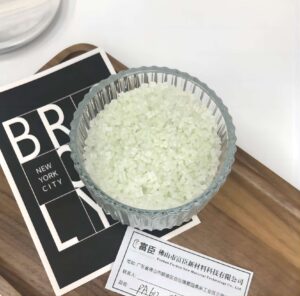PA612 GF33 įvadas
Sparčiai tobulėjančioje medicinos prietaisų gamybos srityje tinkamų medžiagų pasirinkimas yra labai svarbus siekiant užtikrinti tiek pagamintų prietaisų veiksmingumą, tiek saugumą. Viena medžiaga, kuri išsiskyrė šioje srityje, yra PA612 GF33. Šis didelio našumo poliamido junginys, sustiprintas stiklo pluoštu, pasižymi savybių deriniu, dėl kurio jis ypač tinka medicinos reikmėms. Šiame straipsnyje nagrinėjamos unikalios PA612 GF33 savybės ir jo svarbus vaidmuo kuriant medicinos prietaisus.
Kas yra PA612 GF33?
PA612 GF33 yra specializuotas poliamidas 6 junginys, plastiko kategorija, garsėjanti savo tvirtomis mechaninėmis savybėmis ir įvairiomis pritaikymo galimybėmis. „GF“ PA612-GF33 reiškia „stiklo pluoštas“, nurodant, kad poliamidas yra sustiprintas stiklo pluoštu, siekiant padidinti jo stiprumą ir patvarumą. Skaičius „33“ reiškia specifinę šių stiklo pluoštų rūšį, kuri prisideda prie medžiagos aukštų eksploatacinių savybių. Dėl šio derinio PA612-GF33 yra puikus pasirinkimas reiklioms medicinos reikmėms.
Pagrindiniai PA612 GF33 privalumai medicinos prietaisuose
Pagrindinis PA612-GF33 pranašumas medicinos prietaisų gamyboje yra jo biologinis suderinamumas. Tai reiškia, kad naudojant prietaisuose, kurie liečiasi su žmogaus kūnu, jis netrukdo fiziologiniams procesams. Tokia savybė yra labai svarbi kuriant implantuojamus prietaisus ar įrankius, kuriems reikalingas ilgalaikis sąveika su kūno audiniais ir skysčiais. Medžiagų saugos ir suderinamumo užtikrinimas medicinos prietaisuose yra gyvybiškai svarbus paciento saugai ir reguliavimo patvirtinimui.
Išskirtinės mechaninės savybės
PA612-GF33 išsiskiria savo įspūdingomis mechaninėmis savybėmis. Dėl didelio stiprumo ir svorio santykio bei atsparumo deformacijai veikiant įtampai jis idealiai tinka prietaisams, kurie naudojimo metu turi atlaikyti dideles jėgas. Tai apima chirurginius instrumentus ir ortopedinius implantus, kur patvarumas ir patikimumas yra svarbiausi. Tvirtas medžiagos veikimas esant fizinei įtampai užtikrina, kad prietaisai išliks veiksmingi ir saugūs ilgą laiką.
Puikus atsparumas cheminėms medžiagoms
Medicinos prietaisai dažnai susiduria su stipriomis cheminėmis medžiagomis ir tirpikliais, tiek sterilizavimo procesų metu, tiek kontaktuojant su kūno skysčiais. Puikus PA612-GF33 atsparumas chemikalams apsaugo prietaisus nuo degradacijos šiose aplinkose, užtikrindamas ilgaamžiškumą ir veikimą. Šis atsparumas cheminiam poveikiui yra būtinas norint išlaikyti medicinos prietaisų vientisumą ir užtikrinti, kad jie nuosekliai veiktų įvairiomis sąlygomis.
Lengvas gamyba
Kitas reikšmingas PA612-GF33 pranašumas yra jo apdirbamumas. Medžiagą galima lengvai formuoti, ekstruzuoti arba apdirbti į sudėtingas formas, palengvinant sudėtingų ir tikslių medicinos prietaisų gamybą. Šis gamybos metodų universalumas leidžia dizaineriams ir inžinieriams kurti prietaisus su sudėtinga geometrija ir funkcijomis, pagerinant medicinos procedūrų galimybes ir veiksmingumą.
PA 612 GF33 išvada
PA612 GF33 yra labai universali ir didelio našumo medžiaga, kuri atlieka nepakeičiamą vaidmenį medicinos prietaisų gamyboje. Dėl biologinio suderinamumo, puikių mechaninių savybių, tvirto atsparumo chemikalams ir lengvo apdorojimo derinio jis yra puikus pasirinkimas įvairioms medicinos reikmėms. Naudodami PA612-GF33, gamintojai gali gaminti saugesnius, patikimesnius ir novatoriškesnius prietaisus, kurie žymiai pagerina pacientų priežiūrą ir peržengia medicinos technologijų ribas.
Apibendrinant galima pasakyti, kad medicinos prietaisų pramonei toliau tobulėjant, strateginis pažangių medžiagų, tokių kaip PA612-GF33, naudojimas bus būtinas kuriant naujos kartos gyvybes gelbstinčias ir gerinančias medicinos technologijas.
DUK: PA612 GF33 vaidmuo medicinos prietaisų gamyboje
1. Kas yra PA612 GF33?
PA612-GF33 yra didelio našumo poliamido 6 junginys, sustiprintas stiklo pluoštu. „GF“ reiškia „stiklo pluoštas“, o „33“ žymi specifinį naudojamo stiklo pluošto tipą. Ši medžiaga yra žinoma dėl savo išskirtinių mechaninių savybių, atsparumo chemikalams ir biologinio suderinamumo, todėl idealiai tinka medicinos reikmėms.
2. Kodėl PA612 GF33 yra svarbus medicinos prietaisų gamyboje?
PA612-GF33 yra labai svarbus medicinos prietaisų gamyboje dėl savo savybių derinio, kuris užtikrina saugumą, patvarumą ir funkcionalumą sudėtingose medicinos aplinkose. Jis ypač vertinamas dėl savo biologinio suderinamumo, kuris užtikrina, kad jį galima saugiai naudoti kontaktuojant su žmogaus audiniais.
3. Ką reiškia biologinis suderinamumas ir kodėl jis svarbus PA612 GF33?
Biologinis suderinamumas reiškia medžiagos gebėjimą veikti nesukeliant žalingų fiziologinių reakcijų, kai ji naudojama kontaktuojant su kūnu. PA612 GF33 atveju tai reiškia, kad jį galima saugiai naudoti medicinos prietaisuose, kurie yra implantuojami arba ilgą laiką liečiasi su kūnu, pavyzdžiui, ortopediniai implantai ir chirurginiai instrumentai.
4. Kokios yra PA612 GF33 mechaninės savybės?
PA612-GF33 pasižymi dideliu stiprumo ir svorio santykiu bei puikiu atsparumu deformacijai veikiant apkrovai. Dėl šių savybių jis tinka medicinos prietaisams, kurie turi atlaikyti dideles jėgas ar įtampas, užtikrinant, kad jie išliks patikimi ir veiksmingi ilgą laiką.
5. Kaip PA612 GF33 susidoroja su chemikalų poveikiu?
PA612-GF33 pasižymi puikiu atsparumu chemikalams, todėl jis gali išlaikyti savo vientisumą ir veikimą veikiamas stiprių chemikalų ar tirpiklių. Tai ypač svarbu medicinos prietaisams, kurie turi atlaikyti sterilizavimo procesus arba liestis su kūno skysčiais.
6. Ar PA612 GF33 lengva apdoroti gamyboje?
Taip, PA612-GF33 pasižymi geru apdirbamumu, o tai reiškia, kad jį galima lengvai formuoti, ekstruzuoti arba apdirbti į sudėtingas formas ir sudėtingus dizainus. Šis gamybos lankstumas leidžia kurti labai tikslius ir novatoriškus medicinos prietaisus.
7. Kokiuose medicinos prietaisų tipuose dažniausiai naudojamas PA612 GF33?
PA612-GF33 naudojamas įvairiuose medicinos prietaisuose, įskaitant implantuojamus prietaisus, chirurginius instrumentus ir ortopedinius implantus. Dėl savo savybių jis tinka bet kokiai paskirčiai, kuriai reikalingos patvarios, biologiškai suderinamos ir chemiškai atsparios medžiagos.
8. Kaip PA612 GF33 prisideda prie pacientų saugos ir prietaisų naujovių?
Siūlydamas patikimą, biologiškai suderinamą ir tvirtą medžiagą, PA612 GF33 padeda gamintojams gaminti saugesnius ir patvaresnius prietaisus. Tai palaiko novatoriškų medicinos technologijų kūrimą, gerinantį pacientų rezultatus ir plečiantį medicininio gydymo galimybes.
9. Kokių ateities patobulinimų galime tikėtis su PA612 GF33 medicinos technologijose?
Medicinos technologijoms toliau tobulėjant, pažangių medžiagų, tokių kaip PA612-GF33, naudojimas bus labai svarbus kuriant naujus ir patobulintus medicinos prietaisus. Šios medžiagos padės peržengti tai, kas įmanoma pacientų priežiūroje, todėl bus sukurti saugesni, veiksmingesni ir novatoriškesni medicininiai sprendimai.

